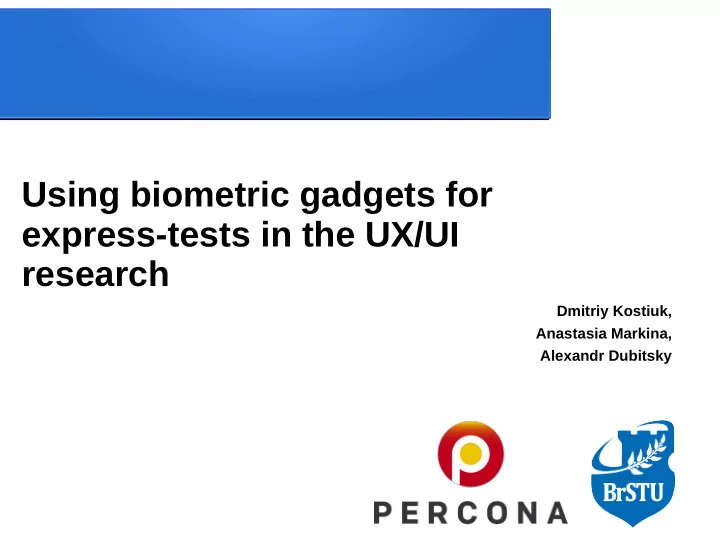

Using biometric gadgets for express-tests in the UX/UI research Dmitriy Kostiuk, Anastasia Markina, Alexandr Dubitsky
Biometrics in usability ● Biometric measuring tools have recently undergone a new wave of attention in the usability researches ● New powerful user-grade measuring gadgets are the reason – Mass-market production for the entertainment and fitness applications made them much cheaper – The precision they provide for contemporary games can be a valuable addition for the UX research
Scheme of Testing ● A User is typing the text, moving mouse, etc. ● Time and errors are taken into account ● Heart rate is measured by a fitness tracker ● Attention level and gaze direction, etc. are estimated by a consumer-grade devices: EEG, eye tracker, etc.
Available biometric parameters to measure ● Galvanic skin response ● Heart rate ● Blood pressure ● Electroencephalography waves (EEG) ● Kinematic activity ● Gaze direction
What we have used? ● EEG: – NeuroSky MindWave – NeuroSky MindSet – Emotiv EPOC/EPOC+ – Emotiv Insight ● Fitness-trackers: – Fibit Charge HR – Xiaomi Mi Band 2/3 – Amazfit Bip ● Tobii eye-trackers
Testing schemes Individual testing mode Parallel testing mode logs logs archive archive logs archive Measured Measured data stored in data stored in a database a database logs archive Our own UXDump project bitbucket.org/AsyaAliset/uxdump or some shell script to run the data acquisition software in parallel
Heart rate, EEG
How to get data from device ● Using universal API If the gadget does not If the gadget does not – Bluez/QtBluetooth, etc. provide biometrics data provide biometrics data (especially in realtime) by (especially in realtime) by ● API from the device vendor itself, the open source itself, the open source may come into the deal may come into the deal – Fitbit web API – Tobii SDK – Special licenses to process personal data are possible ● Special open source tools per device – Mindwave (EEG) – PuzzleBox Synapse project – … a lot more ● File abstraction – Garmin fitness trackers pretend to be just a flash drive with logs
Getting heart rate with the remote access API ... ● … may be ridiculously complicated: Testing PC Launcher, Fitbit HR galileo ……. (pulse) tool Decyphered cyphered data data in sent to JSON web Fitbit.com DB
Evaluation criteria ● duration of the given actions ● number of errors ● heart rate ● attention level – calculated based on beta to alpha waves ratio – pre-calculated metrics (like «Attention» by NeuroSky) are good enough for practical needs ● emotions?
Gaze detection This allows to calculate the ratio between gaze fixations on the object of interest (e.g. tools GNU octave turned out to be the easiest tool panel) and to plot gaze movements and gaze heatmaps the irrelevant areas
Gaze tracking heatmaps: Same task executed by six users Heatmaps in GNU octave:
Two types of test tasks ● Series of different type operations in one program – user is supplied with a set of tasks under one general thematic direction ● e.g. the working with a word processor – assess how the overall layout and dynamics of the application interface affect the user ● Long sequence of routine operations – large amount of the same type tasks – each task involves several applications, or parts – evaluate the contribution of the GUI auxiliary elements
Tests example (office interfaces)
Office interfaces / Results
Office interfaces / Results Users who work best Users who work best with ribbons with top panel max. GSR,% max. HR,%
Tests / Keyboards Hardware keyboard by Asus Onboard from Ubuntu 16.04 Default AOSP Keyboard from Android-x86
Keyboards / Results speed, chars/s mind concentration, a.u. pulse, beats/min errors, % Hardware Onboard AOSP Keyboard keyboard (Ubuntu) (Android)
Conclusions ● Consumer-grade biometrics turned out to be enough mature to be used in the UI/UX comparison – There are enough open source friendly devices on the mass market ● Biometric indicators are really useful in practical evaluation of the humans physical and mental load – Based on the test results, the average values for the listed parameters and the maximum deviation of the parameter from the average component can be easily calculated ● Each of the presented criteria allows to reduce the time series to a single value – This value reflects the nature of the work of a specific user in a particular test
Recommend
More recommend